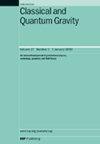A note on the conversion of orbital angles for extreme mass ratio inspirals
IF 3.7
3区 物理与天体物理
Q2 ASTRONOMY & ASTROPHYSICS
引用次数: 0
Abstract
We outline a practical scheme for converting between three commonly used sets of phases to describe the trajectories of extreme mass ratio inspirals; quasi-Keplerian (QK) angles, Mino time (MT) action-angles, and Boyer–Lindquist (BL) time action-angles (as utilised by the FastEMRIWaveform package). Conversion between BL time action angles (AAs) and QK angles is essential for the construction of a source frame for adiabatic inspirals that can be related to the source frames used by other gravitational wave source modelling techniques. While converting from QK angles to BL time AAs via MT action-angles can be done analytically, the same does not hold for the converse, and so we make use of an efficient numerical root-finding method. We demonstrate the efficacy of our scheme by comparing two calculations for an eccentric and inclined geodesic orbit in Kerr spacetime using two different sets of orbital angles. We have made our implementations available in Mathematica, C, and Python.关于极端质量比吸气的轨道角转换的注释
我们概述了一种实用的方案,用于在三种常用的相集之间转换,以描述极端质量比吸气的轨迹;准开普勒角(QK)、米诺时间角(MT)和波耶-林德奎斯特时间角(BL)(由fastemri波形包使用)。在BL时间作用角(AAs)和QK角之间的转换对于绝热激励源框架的构建至关重要,而绝热激励源框架可以与其他引力波建模技术使用的源框架相关联。虽然通过MT作用角可以解析地从QK角度转换为BL时间aa,但反之则不成立,因此我们使用了一种有效的数值寻根方法。通过对克尔时空中偏心和倾斜测地线轨道使用两组不同轨道角的计算结果进行比较,证明了该方案的有效性。我们已经在Mathematica、C和Python中提供了我们的实现。
本文章由计算机程序翻译,如有差异,请以英文原文为准。
求助全文
约1分钟内获得全文
求助全文
来源期刊

Classical and Quantum Gravity
物理-天文与天体物理
CiteScore
7.00
自引率
8.60%
发文量
301
审稿时长
2-4 weeks
期刊介绍:
Classical and Quantum Gravity is an established journal for physicists, mathematicians and cosmologists in the fields of gravitation and the theory of spacetime. The journal is now the acknowledged world leader in classical relativity and all areas of quantum gravity.
 求助内容:
求助内容: 应助结果提醒方式:
应助结果提醒方式:


